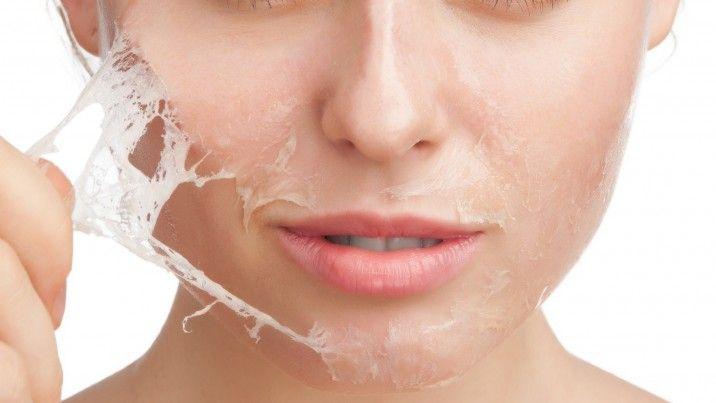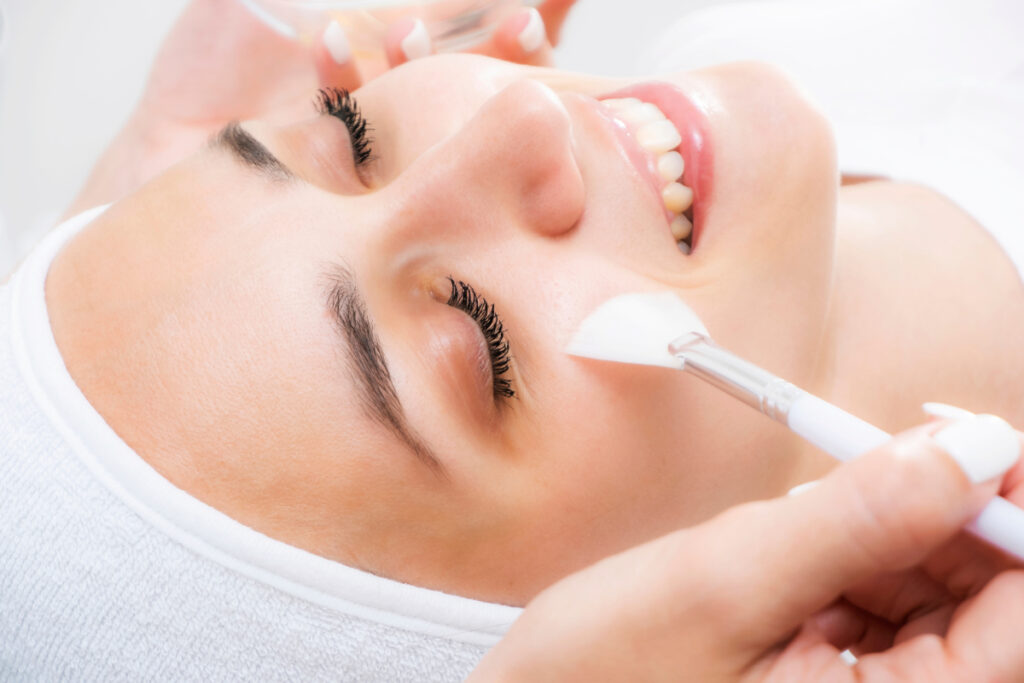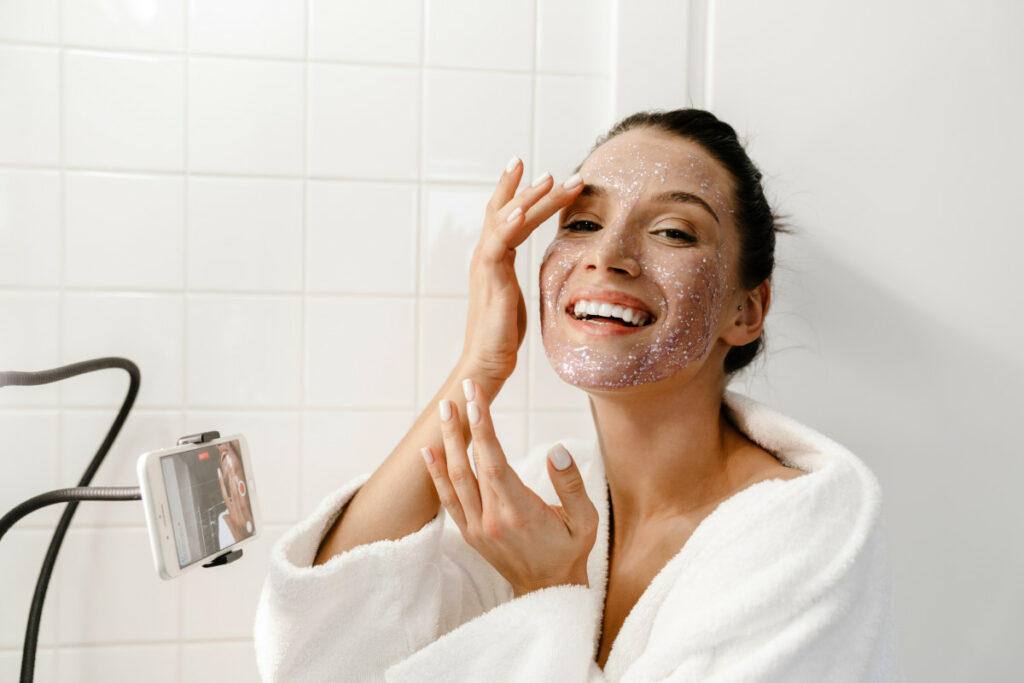Table of Contents
Exfoliation – What is it and What are its Effects?
Does your complexion appear dull, tired, and lacking that healthy glow? Perhaps you’re battling clogged pores, uneven skin tone, or the early signs of wrinkles. If so, your skin might be yearning for exfoliation, the process of removing dead skin cells.
This article delves deep into this crucial skincare step. We’ll answer the questions: what is exfoliation, what are its different types, and what effects can we expect from incorporating it into our routine? We’ll also explore how to properly exfoliate and choose the right method for your skin type.
Understanding Exfoliation
Exfoliation, often referred to as peeling, is the process of removing dead skin cells that naturally accumulate on the surface of your skin. While these cells shed naturally over time, the process can slow down with age. This results in a buildup of dead skin, making your complexion appear dull, tired, and lacking radiance.
Regular exfoliation helps restore your skin’s natural glow. It removes this dead layer, revealing smoother, brighter, and more even-toned skin. Additionally, it enhances the absorption of active ingredients found in your skincare products, maximizing their effectiveness.
The Two Main Types of Exfoliation
There are two primary methods of exfoliation:
- Mechanical Exfoliation: This method relies on physical exfoliants like scrubs with grainy textures, exfoliating tools (such as brushes), or enzymatic peels. These physically remove dead skin cells from the surface.
- Chemical Exfoliation: This method uses chemical exfoliants like acids (AHAs and BHAs) to dissolve the bonds between dead skin cells, allowing them to be easily removed.
Mechanical exfoliation is generally suited for oily and combination skin types that can tolerate a bit more abrasion. Chemical exfoliation tends to be gentler and more suitable for sensitive skin types due to its less abrasive nature.
Choosing the right method depends on your individual skin type and needs. Consulting a dermatologist can help determine the best approach for you.
The Benefits of Regular Exfoliation
Regular exfoliation offers a multitude of benefits for your skin. Here are some of the most noteworthy:
- Enhanced Radiance: Removing dead skin cells reveals a brighter, more radiant complexion.
- Smoother, Firmer Skin: Exfoliation smooths out rough texture and can improve skin firmness.
- Minimized Pores: By removing dead skin cells and debris that clog pores, exfoliation helps prevent breakouts and minimizes the appearance of existing pores.
- Reduced Wrinkles: Exfoliation can stimulate collagen production, which helps reduce the appearance of fine lines and wrinkles.
- Improved Product Absorption: Exfoliation removes the barrier of dead skin cells, allowing skincare products to penetrate deeper and work more effectively.
The Art of Proper Exfoliation
To reap the benefits of exfoliation without irritating your skin, it’s crucial to follow proper techniques. Here are some key tips:
- Choose the Right Exfoliant: Select an exfoliating product suitable for your skin type.
- Cleanse Thoroughly: Always cleanse your face before exfoliating to remove dirt, oil, and makeup.
- Gentle Massage: Apply the exfoliant and massage it gently in circular motions for a short period.
- Avoid the Eye Area: The skin around the eyes is delicate; avoid contact with exfoliants.
- Tone and Moisturize: Follow up with toner and a moisturizer to soothe and hydrate your skin.
- Frequency: The frequency of exfoliation depends on your skin type. Generally, aim for 1-2 times a week for mechanical exfoliation and follow the instructions for chemical exfoliants.
When to Avoid Exfoliation
While generally safe for most skin types, there are situations when exfoliation should be avoided:
- Active Breakouts: If your skin is experiencing active breakouts or open wounds, exfoliation can worsen irritation.
- Sunburned Skin: Avoid exfoliating sunburned skin, as it’s already compromised.
- Sensitive Skin: If you have very sensitive skin, start with a gentler method and patch test before full application.
- Certain Skin Conditions: Some skin conditions, like eczema or rosacea, may require consultation with a dermatologist before exfoliating.
Post-Exfoliation Care
After exfoliation, your skin is typically more sensitive to sunlight. Applying a broad-spectrum sunscreen with SPF 50+ is essential to protect your newly revealed skin. Additionally, focus on proper hydration by using a gentle moisturizer or calming serum.
By incorporating regular exfoliation into your routine, you can achieve a healthier, brighter, and more youthful-looking complexion. Remember, choosing the right exfoliant depends on your individual skin type and needs. Here’s a breakdown to help you navigate the options:
-
Oily and Combination Skin: These skin types can tolerate mechanical exfoliants with slightly grainy textures, like scrubs containing sugar or jojoba beads. Opt for chemical exfoliants with salicylic acid (BHA), known for its ability to penetrate deeper into pores and combat oiliness.
-
Dry and Sensitive Skin: For these delicate complexions, gentle chemical exfoliation is recommended. Look for products containing alpha hydroxy acids (AHAs) such as lactic acid or glycolic acid, which work by dissolving the dead skin cells without harsh abrasion. Opt for enzyme peels containing fruit enzymes like papaya or pineapple, which offer a very gentle approach.
-
Mature Skin: As skin ages, it becomes thinner and more sensitive. Choose gentle chemical exfoliants with AHAs like lactic acid. Consider exfoliating mitts or washcloths for a very mild physical exfoliation option.
Always patch test a new exfoliating product on a small area of your inner arm before applying it to your face. This helps identify any potential allergic reactions.
Maintaining a Balanced Routine: Exfoliation and Beyond
While exfoliation is a valuable step, it should be integrated into a well-rounded skincare routine. Here are some additional tips:
- Cleansing: Cleanse your face twice daily, morning and night, to remove dirt, oil, and makeup. Choose a cleanser suitable for your skin type.
- Moisturizing: Regardless of your skin type, proper hydration is crucial. Apply a moisturizer appropriate for your needs after cleansing and exfoliation.
- Sunscreen: Sun protection is vital for healthy skin. Apply a broad-spectrum sunscreen with SPF 50+ daily, even on cloudy days.
- Listen to Your Skin: Pay attention to how your skin reacts to different products and techniques. Adjust your routine as needed and don’t be afraid to consult a dermatologist for personalized advice.
Conclusion
Exfoliation is a powerful tool for achieving a healthy, radiant, and youthful complexion. By understanding the different types, choosing the right method for your skin, and incorporating it into a balanced routine, you can unlock the full potential of this essential skincare step. Remember, consistency is key! With regular exfoliation and a well-rounded skincare regimen, you’ll be well on your way to achieving your best skin ever.












